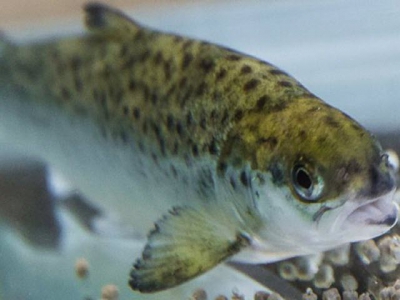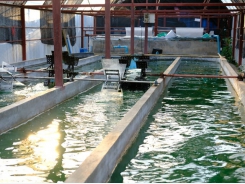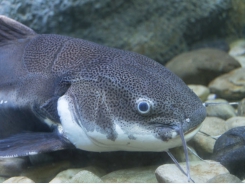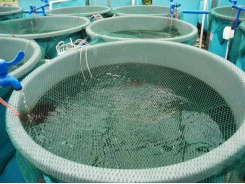Zinc, omega-3 fatty acids influence salmon health

Nutrients provide important interaction in barrier tissues of salmon intestines and gills, with implications for recirculating systems and aquaculture.
Salmon require sufficient amounts of zinc and marine omega-3 in their feed in order for skin, gill and intestine barrier tissues to remain intact, robust and withstand the transition to seawater. Photo: Terje Aamodt © Nofima.
Previously, researchers at Nofima, an applied research institute for fisheries, aquaculture and food in Norway, reported that salmon skin is strengthened if there is enough omega-3 fatty acids and zinc in their feed. Now, a new report shows that these nutrients also provide an important interaction in the intestines and likely the gills of salmon, Nofima said in an announcement.
There is a shortage of marine omega-3 fatty acids, and there are limits as to how much zinc is allowed in the feed due to environmental considerations, Nofima said. At the same time, these nutrients are important for salmon. Therefore, Nofima senior scientist Gerd Marit Berge believes it is especially important to utilize omega-3 fatty acids and zinc well, and this means that knowledge about interaction is important.
“This is one of only a few projects where scientists are given the opportunity to delve into the effects of interactions between different nutrients. The project group worked really well together due to the cooperation of several disciplines within the fields of nutrition, feed, health and genetics. We found important interaction effects, and I feel that there’s a lot to gain by working in this manner,” Berge said.
There are several reasons why scientists have examined the correlation among zinc, the marine omega-3 fatty acids eicosapentaenoic acid (EPA) and docosahexaenoic acid (DHA) and the skin, intestine and gill barrier tissues of salmon, Nofima said. The barrier tissues are salmon's first line of defense against all kinds of external influences, from poor water quality and handling to exposure to pathogens.
In a time when more salmon are held in recirculated water, the fish are exposed to a completely different aquatic environment with different densities of fish, microbiota and particles compared to flow-through systems, Nofima said. At the same time, the composition of feed is also changing, with a high proportion of plant-based raw materials. There isn’t enough knowledge about how this affects the function of the barrier tissues.
The addition of zinc in salmon feed is controversial, Nofima said, noting that salmon require the mineral, so it must be part of the diet, but at the lowest possible concentration if the waste sludge is to be used as a plant fertilizer.
“So, when it comes to both marine omega-3 fatty acids and zinc, we wanted to test whether changes in feed composition would affect the health and robustness of salmon,” Berge said.
The tests were conducted on salmon from parr to post-smolt size in recirculating aquaculture systems at Nofima in Sunndalsøra, Norway, where extensive samples were taken from the salmon during the tests.
Cell wall composition
The amount of zinc in the feed has a distinct effect on the composition of phospholipids regarding skin, intestine and gill barrier tissues, Nofima reported. Phospholipids are building blocks in cell membranes, and changes in composition can be of crucial significance regarding the tissues’ function as a barrier against external influences, the institute added.
The level of omega-3 fatty acids in the feed also seems to have an effect on the utilization of zinc in that it affects the absorption of zinc in the intestines and the level of zinc in whole salmon, Nofima said.
“We have noticed that it is necessary to have enough omega-3 to best utilize zinc in the feed, and enough zinc is important to achieve a good composition of phospholipids, which, in turn, provides a good barrier function. Such interaction between nutrients is important to understand,” Berge said.
Reduced EPA and DHA content in the feed resulted in reduced levels of the same fatty acids in phospholipids in the skin, intestines and gills, Nofima noted.
The research shows that less omega-3 in the feed can reduce the intestinal barrier function by disrupting fluid absorption and salt balance regulation, according to the institute. Since the intestinal function changes, the researchers suggested that the level of omega-3s in feed can also affect the absorption of nutrients other than zinc.
The research also shows that the various layers of the skin are strengthened by omega-3 fatty acids and zinc and that both of these nutrients contribute to strengthening the ability to heal wounds.
Gill tissue
According to Nofima, different levels of both zinc and omega-3s in the gills led to altered expressions in a large number of genes, especially when transferring to seawater. The genes were linked to functions such as tissue organization, metabolism and signal transmission.
“In general, the changes in gene expression suggest a comprehensive reorganization of gill tissue when transferring the salmon to sea water. Salmon go through a process of major physiological changes before they are transferred to seawater, and if we can give them one type of feed that better meets the demands of this period, it can contribute to higher survival rates at sea,” Berge said.
For the project, Nofima collaborated with the University of Gothenburg and Oslo University Hospital. The project was funded by the Norwegian Seafood Research Fund (FHF).
“We hope the project results provide new knowledge that will help improve the function and health of barrier tissues, thereby contributing to better fish welfare and increased survival rates and fewer losses after transferring to sea,” Sven Martin Jørgensen, head of fish health at FHF, said.
Related news
Tools

Phối trộn thức ăn chăn nuôi

Pha dung dịch thủy canh

Định mức cho tôm ăn

Phối trộn phân bón NPK

Xác định tỷ lệ tôm sống

Chuyển đổi đơn vị phân bón

Xác định công suất sục khí

Chuyển đổi đơn vị tôm

Tính diện tích nhà kính

Tính thể tích ao




 Research targets domestic production of marine fish
Research targets domestic production of marine fish  Probiotic gives growth, immune response in farmed carp
Probiotic gives growth, immune response in farmed carp